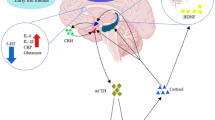Abstract
The study included 102 elderly patients suffering from hemorrhagic stroke (HS) of various volumes, localization, and severity undergoing conservative treatment. Our research results demonstrate a high pathogenetic importance of the free radical processes for HS cases. The intensity of the oxidative stress, which is a direct reflection of the energy deficit, correlates with the severity of the patients’ condition, the volume of intracerebral hematoma, and hyperglycemia, and it predetermines the outcome of the disease. The administration of the energy-correcting antioxidant Cytoflavine resulted in the elimination of the free radical imbalance, a faster recovery of impaired consciousness and the focal neurological deficiency, as well as in an improved functional outcome of the disease and decreased disability.
Similar content being viewed by others
References
Gemorragicheskii insul’t: Prakticheskoe rukovodstvo (Hemorrhagic Stroke: Handbook), Skvortsova, V.I. and Krylova, V.V., Eds., Moscow: Geotar-Media, 2005.
Gusev, E.I., Skvortsova, L.V., Stakhovskaya, L.V., et al., Epidemiology of stroke in Russia, Consilium medicum (Nevrol.), 2003, special suppl., pp. 5–7.
Zozulya, Yu.A., Baraboi, V.A., and Sutkovoi, D.A., Svobodnoradikal’noe okislenie i antioksidantnaya zashchita pri patologii golovnogo mozga (Free Radical Oxidation and Antioxidant Protection at the Brain Pathology), Moscow: Znanie-M, 2000.
Piradov, M.A., Hemorrhagic stroke: new approaches to diagnostics and treatment, Nervn. Bolezni, 2005, no. 1, pp. 17–19.
Rumyantseva, S.A., Stupin, V.A., Afanas’ev, V.V., et al., Vtoroi shans (sovremennye predstavleniya ob energokorrektsii) (Second Chance: Current Concepts on Energetic Correction), Moscow: Meditsinskaya Kniga, 2011.
Zygun, D.A., Kortbeek, J.B., and Fick, G.H., Non-neurologic organ dysfunction in severe traumatic brain injury, Crit. Care Med., 2005, vol. 33, no. 3, pp. 654–660.
Author information
Authors and Affiliations
Corresponding author
Additional information
Original Russian Text © E.V. Silina, S.A. Rumyantseva, S.B. Bolevich, 2013, published in Uspekhi Gerontologii, 2013, Vol. 26, No. 2, pp. 275–280.
Rights and permissions
About this article
Cite this article
Silina, E.V., Rumyantseva, S.A. & Bolevich, S.B. Energy correction of hemorrhagic stroke in elderly patients. Adv Gerontol 4, 62–66 (2014). https://doi.org/10.1134/S207905701401010X
Published:
Issue Date:
DOI: https://doi.org/10.1134/S207905701401010X




